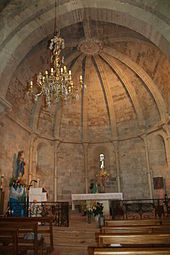Paulhan
| Paulhan | ||
|---|---|---|

|
|
|
| region | Occitania | |
| Department | Herault | |
| Arrondissement | Lodève | |
| Canton | Clermont-l'Hérault | |
| Community association | Clermontais | |
| Coordinates | 43 ° 33 ' N , 3 ° 28' E | |
| height | 18-83 m | |
| surface | 11.26 km 2 | |
| Residents | 3,937 (January 1, 2017) | |
| Population density | 350 inhabitants / km 2 | |
| Post Code | 34230 | |
| INSEE code | 34194 | |
| Website | http://www.paulhan.fr/ | |
 Church Notre-Dame de Vertus |
||
Paulhan ( Occitan : identical) is a place and a municipality in the south of France with 3937 inhabitants (as of January 1, 2017) in the Hérault department in the Occitania region .
location
The circular village ( Circulade ) Paulhan is located on the Hérault River at an altitude of about 36 meters above sea level. d. M. about 35 kilometers (driving distance) northeast of Béziers ; the small town of Pézenas is only about ten kilometers to the south-west.
Population development
| year | 1968 | 1975 | 1982 | 1990 | 1999 | 2006 | 2017 |
| Residents | 2421 | 2276 | 2379 | 2580 | 2634 | 3195 | 3937 |
Since the early 19th century (the population was around 1,000 at that time) - despite the phylloxera crisis and the progressive mechanization of agriculture - population growth has been almost constant.
economy
In earlier times, the residents of the village lived largely on self-sufficiency from agriculture, with both grain and wine being grown. In addition, they ran a little cattle (pigs, chickens, etc.). As in many places in Languedoc , viticulture dominated in the 19th century; the local winegrowers' cooperative markets the wine produced here through the Clairette du Languedoc , Languedoc , Pays d'Herault and Pays d'Oc appellations . Because of the sales crisis for French wine, however, only about half of the agricultural land is still viniculture; on the other half, grain ( wheat , maize ) and sunflowers are grown again.
history
The place name is possibly derived from the name Paulianus of a landowner from Gallo-Roman times. In 990 the place belonged to the vice counts ( vicomtes ) of Béziers . In 1137 the place was in the hands of the lords of Montpellier .
Attractions
- The old town center of Margon belongs to the type of Circulades - round villages that were built around a core consisting of a castle and / or church for defense reasons and whose outer house front served as a replacement for an expensive city wall.
- The former parish church of Notre-Dame des Vertus is a single-nave Romanesque building from the late 12th and early 13th centuries made of precisely hewn stones , which rises on an ancient site dedicated to the goddess Ceres . The west tower was renewed during later renovations and the portal originally located on the south side was relocated to the west. The exterior of the choir of the church building, which is lengthened by a fore- choir yoke, shows only a vertical structure with buttresses and an unadorned console frieze as the upper end. Inside, the structure of the apse is much more delicate: on the lower level there are slender columns with shaft rings and slender capitals that show an almost Gothic sense of shape; a profiled and cranked cornice runs above it . The apse dome is underpinned by triple-profiled belt arches that end in a large keystone with a rosette motif. The choir of the church was recognized as a monument historique in 1987 .
- The new parish church of Sainte-Croix was built in 1903.
- The hermit church ( L'ermitage Saint-Jean de Vareilhes ) is about a kilometer outside the village. Although it was later restored, it is the only remnant of the old village of Vareilhes .
Community partnerships
- Krailling , Upper Bavaria
- Brezová pod Bradlom , Slovakia
Web links
- Paulhan, Wine - Info (French)
Individual evidence
- ↑ Église Notre-Dame des Vertus, Paulhan in the Base Mérimée of the French Ministry of Culture (French)

